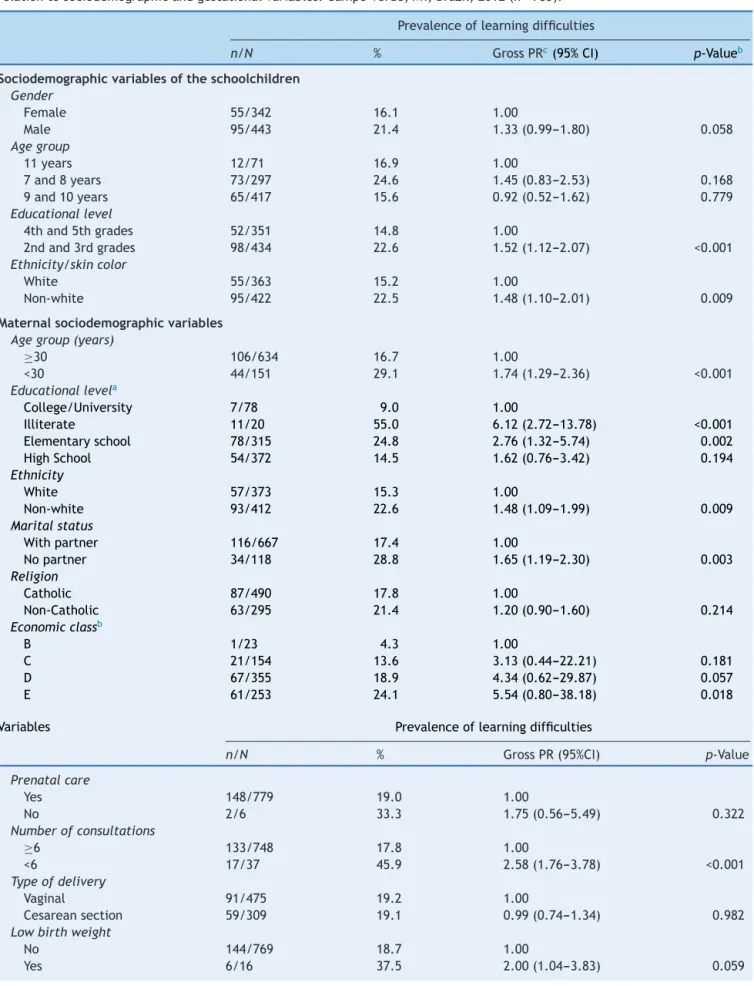www.jped.com.br
ORIGINAL
ARTICLE
Influence
of
passive
smoking
on
learning
in
elementary
school
夽
Juliana
Gomes
Jorge
a,∗,
Clóvis
Botelho
b,
Ageo
Mário
Cândido
Silva
c,
Gisele
Pedroso
Moi
daUniversidadeFederaldeMatoGrosso(UFMT),Cuiabá,MT,Brazil
bSchoolofMedicine,UniversidadeFederaldeMatoGrosso(UFMT),Cuiabá,MT,Brazil cInstitutodeSaúdeColetiva,UniversidadeFederaldeMatoGrosso(UFMT),Cuiabá,MT,Brazil dCentroUniversitáriodeVárzeaGrande(UNIVAG),VárzeaGrande,MT,Brazil
Received28November2014;accepted26August2015 Availableonline6February2016
KEYWORDS
Smoking; Tobaccosmoke pollution;
Learningdisorders; Children
Abstract
Objective: Toanalyze the associationbetween household smoking andthe developmentof
learninginelementaryschoolchildren.
Methods: Cross-sectionalstudywith785studentsfromthe2ndtothe5thyearofelementary
school.StudentswereevaluatedbytheSchoolLiteracyScreeningProtocoltoidentifythe
pres-enceoflearningdisabilities.Mothers/guardianswereinterviewedathomethroughavalidated
questionnaire.Descriptiveandbivariateanalysis,aswellasmultivariatePoisson regression,
wereperformed.
Results: In thefinalmodel, thevariables associated withlearning difficulties were current
smokingatthehouseholdinthepresenceofthechild(PR=6.10,95%CI:4.56to8.16),maternal
passivesmokingduringpregnancy(PR=1.46,95%CI:1.07to2.01),studentsattendingthe2nd
and3rdyearsofElementarySchool(PR=1.44, 95%CI:1.10to1.90),andbeing childrenof
motherswithonlyelementaryleveleducation(PR=1.36,95%CI:1.04to1.79).
Conclusion: Thestudydemonstratedanassociationbetweenpassiveexposuretotobaccosmoke
andlearningdifficultiesatschool.
©2016SociedadeBrasileiradePediatria.PublishedbyElsevierEditoraLtda.Allrightsreserved.
PALAVRAS-CHAVE
Tabagismo;
Poluic¸ãoporfumac¸a detabaco;
Influênciadotabagismopassivonaaprendizagemdeescolares
Resumo
Objetivo: Analisaraassociac¸ãoentreotabagismodomiciliareodesenvolvimentoda
apren-dizagememescolaresdoensinofundamental.
夽
Pleasecitethisarticleas:JorgeJG,BotelhoC,SilvaAM,MoiGP.Influenceofpassivesmokingonlearninginelementaryschool.JPediatr
(RioJ).2016;92:260---7.
∗Correspondingauthor.
E-mail:julianafono56@hotmail.com(J.G.Jorge).
http://dx.doi.org/10.1016/j.jped.2015.08.010
Transtornosde Aprendizagem; Crianc¸as
Métodos: Estudotransversal,com785 escolaresdo2◦ ao 5◦ anodoensino fundamental.Os
alunosforamavaliadospormeiodoProtocolodeTriagemdeLetramentoEscolar,visando
iden-tificarapresenc¸adedificuldadesdeaprendizagem.Asmães/responsáveisforamentrevistadas
nodomicíliopormeiodequestionáriovalidado.Foramrealizadasanálisesdescritiva,bivariada
eregressãomúltipladePoisson.
Resultado: No modelo final, asvariáveis associadas àsdificuldades deaprendizagem foram
tabagismoatualdomiciliarnapresenc¸adofilho(RP=6,10;IC95%4,56---8,16),tabagismopassivo
maternoduranteagestac¸ão(RP=1,46;IC95%1,07---2,01),alunospertenceremao2◦e3◦ano
doensinofundamental(RP=1,44;IC95%1,10---1,90)eseremfilhosdemãescomapenasonível
fundamentaldeescolaridade(RP=1,36;IC95%1,04---1,79).
Conclusão: oestudoevidenciouassociac¸ãoentreaexposic¸ãopassivaaotabacoeasdificuldades
deaprendizagemnosescolares.
©2016SociedadeBrasileiradePediatria.PublicadoporElsevierEditoraLtda.Todososdireitos
reservados.
Introduction
Thedevelopmentofreadingandwritingbythechildresults fromtheinteractionbetweenbiologicalcharacteristicsand multiplefamilysocioculturalfactors.1Oneofthemain neg-ativeinfluencesinthisprocessistheexposureofchildren to cigarette smoke, due to its interference with several physiological processes andcognitive functions related to learning.2---4 InBrazil andother countrieswithhigh preva-lenceof smoking,5 this exposure is amajor publichealth problem.
Householdtobaccosmokeisthemostcommonair pollut-antinsidehomes;itsconcentrationmayvarydependingon the numberof smokers in the householdand the number of cigarettes smoked by those individuals. Intense expo-sure to this type of air pollutioncan lead tointellectual disabilityandcognitiveimpairmentin children,aswellas resultinotherdeleteriouseffectsrelatedtomaternaland child health, such as miscarriage, low birth weight, and prematurity.6
Maternal smoking during pregnancy can lead to pre-mature placental maturation and reduce its nutritional capacity,causingchangesinfetalgrowth.Carbonmonoxide andnicotinepresentincigarettesmokearerapidlyabsorbed by the placenta, affecting the mental, intellectual, and behavioral development of these children, in addition to othercomplicationsdescribedinliterature.7---9
The mechanismsthroughwhich tobaccoacts on cogni-tivefunctionhaveyet tobefullyunderstood.Exposureto tobaccosmokecanleadtofetalhypoxia duetoincreased blood carbon monoxide concentrations, resulting in sev-eral neurotoxic effects on the child’s neuropsychomotor development.10 Therefore, children born to mothers who smoke during pregnancy and who are constantly exposed toenvironmentaltobaccosmoke,especiallyinearly child-hood, are at increased risk of experiencing alterations in theirintellectualcapacities,mentaldisorders,andhearing loss,6inadditiontoagreaterprobabilityofhavinglearning difficulties.2
There is a growing interest in the search for under-standing the multiple factors that affect growth and neuropsychomotordevelopmentofchildren,consideringthe
highprevalenceof learningdisabilitiesatschoolage. Itis also important to implement public policies to recognize thedeleterious effectsof concomitant passive andactive smokingof adultsand children, both in external environ-ments and in family homes. Thus, the aim of this study wastoanalyzetheassociationbetweenhouseholdsmoking andthelearningdevelopmentof schoolchildrenattending elementaryschool.
Methods
Across-sectional study wascarried outwith785 students fromsevenmunicipalandstateurbanpublicschoolsinthe municipalityofCampoVerde.CampoVerdeislocatedinthe Southeastregion ofthe state of Mato Grosso, andhas an areaof4795km2,analtitudeof736mabovesealevel,and
apopulationof31,000inhabitants;ithasthehighest agricul-turalGDPofBrazilduetothelargeproductionofsoybeans, cotton,corn,sorghum,sunflower,andpoultry.11
Data collection occurred in two stages: in the first, thestudentsparticipatedoftheSchoolLiteracyScreening Protocol13fortheassessmentoflearningdifficulties,applied bythe mainresearcher intheir ownschool.This protocol consistsoftenquestionsaboutperformingtaskssuchas pair-ingletters,wordsandnumbers,serialletteridentification, words andnumbers, naming of lettersand words, writing nameandsurname,writinglettersandwords,word dicta-tion,readingwords, readingsentences, and phrasalcloze test(fivesentenceswereshownwithablankineachanda supportchart,tobeusedtocompletethesesentences;the studentcompletedthemsothattheymadesense).The max-imumscorethatastudentcouldachievewas30pointsand theminimum,zeropoints.Subsequently,thestudentswho hadaperformanceabovethescoremedianwereconsidered ashaving‘‘normallearningstatus’’and,uptothemedian (20.5),as‘‘alteredstatus’’forlearningdevelopment.
At the second stage,informationwascollected onthe schoolchildren’s households from every child’s mother or guardian.Thesedatawereusedtocharacterize thestatus ofexposuretomaternalsmokingandthechild’sthroughthe Fagerström14 questionnaire, adapted15 and validated16 for thePortugueselanguage.Atthisstageeightundergraduate studentsassisted,fromtheSchoolofEducationofFaculdade CândidoRondoninCampoVerde,previouslytrainedforthis activity.
The information onthe children’spassive smokingand associated factors were obtained by applying a question-naire divided into seven parts: the first and the second partscontainedquestionsrelatedtoidentification dataof the child and mother.The third part containedquestions relatedtogestationaldataofthestudent,suchas: prena-tal care, type of delivery, gestational age and weight at birth, and maternal consumption habits such as alcohol, tobacco,drugs,andmedication.Thefourthpartwasrelated to sociodemographic information, including ownership of assets,paternaleducation,familyincome,numberof house-holdmembers,andeconomicclassaccordingtotheBrazilian AssociationofResearchCompanies(Associac¸ãoBrasileirade Empresas de Pesquisas [ABEP]).17 The fifth and the sixth partcontainedquestionsrelatedtosmoking:pastorcurrent smokinghistoryofthemother,father,orothermembersof thehousehold andtobaccouse inside the household.The seventhandlastpartwasrelatedtofactorsassociatedwith learningdifficulties.
DataweredoubleenteredusingtheEpi-Info7.0software (EpiInfoTM,GA,USA)andbyusingtheDataCompare
applica-tion,whichbelongstothesameprogram;thetypingerrors weredetectedandcorrected.
The bivariate analysis identified the gross associations through the chi-squared test for a prevalence ratio with 95%confidenceintervalusingtheMantel---Haenszelmethod orFisher’sexacttest,whenindicated.Possibleinteractions andconfoundingfactorswereexamined throughstratified analysis,usingasstratificationvariablesthosethatthe lit-eraturereportsasimportant.
Poisson multiple regression analysis was performed in blocks (block 1 --- sociodemographic variables of the students;block 2 --- maternal sociodemographicvariables; block3---gestationalvariables;block4---typeofmaternal smoking),includingineachblockallvariableswithap-value <0.20 in the bivariate analysis through the step-by-step
forwardmethod,retaininginthefinalmodelthevariables withsignificancelevel<0.05.Thedatawereanalyzedusing the statistical software Epi-Info7.0 (Epi InfoTM, GA, USA)
and Stata version 13.0 (StataCorp. 2013. Stata Statistical Software:Release13.CollegeStation,TX,USA).
Theprojectwasapprovedbythe EthicsCommitteefor ResearchinhumansubjectsofHospitalJulioMüller,under No. 45671. All those involved in the research signed the informed consent, according to Resolution 196/96 of the NationalEthicsCommitteeonResearch(ComissãoNacional deÉticaemPesquisa[CONEP]).
Results
Ofthe790eligiblestudentsforthestudy,fiveparticipants wereexcludedduetothemother’srefusaltoparticipateor changeofaddressduringthedatacollectionperiod,totaling 785students,agedbetween7and11years(Table1).The prevalenceoflearningdifficultiesdetectedbytheliteracy testwas19.1%.Asforthesociodemographiccharacteristics ofthestudents,56.4%weremales,67.0%wereyoungerthan 9 years old,55.3% attended the 3rdgrade of elementary school,andwhiteethnicitywasthemostfrequent(46.2%). At the bivariate analysis, male students (PR=1.33, 95% CI: 0.99 to 1.80), attending the 2nd and 3rd grades of Elementary School (PR=1.52, 95% CI: 1.12 to 2.07) and non-whites (PR=1.48, 95% CI: 1.10 to 2.01) were statisticallyassociatedwithlearningdifficulties.Regarding
Table 1 Distribution of schoolchildren according to
sociodemographic characteristics, municipality of Campo
Verde,MT,Brazil,2012(n=785).
Variables N %
Students’sociodemographicvariables
Learningdifficulties
Normal 635 80.9
Altered 150 19.1
Gender
Male 443 56.4
Female 342 43.6
Age
7Years 120 15.2
8Years 177 22.5
9Years 229 29.3
10Years 188 23.8
11Years 71 9.2
Educationallevel
2ndYear 227 28.9
3rdYear 207 26.4
4thYear 174 22.2
5thYear 177 22.5
Ethnicity/skincolor
White 363 46.2
Black 69 8.8
Brown 349 44.5
Yellow 4 0.5
Learningdifficulties
Normal 635 80.9
Table2 Learningdifficulties amongelementaryschoolstudents: prevalenceratio (PR)andconfidenceinterval (95%CI)in
relationtosociodemographicandgestationalvariables.CampoVerde,MT,Brazil,2012(n=785).
Prevalenceoflearningdifficulties
n/N % GrossPRc(95%CI) p-Valueb
Sociodemographicvariablesoftheschoolchildren
Gender
Female 55/342 16.1 1.00
Male 95/443 21.4 1.33(0.99---1.80) 0.058
Agegroup
11years 12/71 16.9 1.00
7and8years 73/297 24.6 1.45(0.83---2.53) 0.168
9and10years 65/417 15.6 0.92(0.52---1.62) 0.779
Educationallevel
4thand5thgrades 52/351 14.8 1.00
2ndand3rdgrades 98/434 22.6 1.52(1.12---2.07) <0.001
Ethnicity/skincolor
White 55/363 15.2 1.00
Non-white 95/422 22.5 1.48(1.10---2.01) 0.009
Maternalsociodemographicvariables
Agegroup(years)
≥30 106/634 16.7 1.00
<30 44/151 29.1 1.74(1.29---2.36) <0.001
Educationallevela
College/University 7/78 9.0 1.00
Illiterate 11/20 55.0 6.12(2.72---13.78) <0.001
Elementaryschool 78/315 24.8 2.76(1.32---5.74) 0.002
HighSchool 54/372 14.5 1.62(0.76---3.42) 0.194
Ethnicity
White 57/373 15.3 1.00
Non-white 93/412 22.6 1.48(1.09---1.99) 0.009
Maritalstatus
Withpartner 116/667 17.4 1.00
Nopartner 34/118 28.8 1.65(1.19---2.30) 0.003
Religion
Catholic 87/490 17.8 1.00
Non-Catholic 63/295 21.4 1.20(0.90---1.60) 0.214
Economicclassb
B 1/23 4.3 1.00
C 21/154 13.6 3.13(0.44---22.21) 0.181
D 67/355 18.9 4.34(0.62---29.87) 0.057
E 61/253 24.1 5.54(0.80---38.18) 0.018
Variables Prevalenceoflearningdifficulties
n/N % GrossPR(95%CI) p-Value
Prenatalcare
Yes 148/779 19.0 1.00
No 2/6 33.3 1.75(0.56---5.49) 0.322
Numberofconsultations
≥6 133/748 17.8 1.00
<6 17/37 45.9 2.58(1.76---3.78) <0.001
Typeofdelivery
Vaginal 91/475 19.2 1.00
Cesareansection 59/309 19.1 0.99(0.74---1.34) 0.982
Lowbirthweight
No 144/769 18.7 1.00
Table2 (Continued.)
Variables Prevalenceoflearningdifficulties
n/N % GrossPR(95%CI) p-Value
Pretermbirth
No 138/716 19.3 1.00
Yes 12/69 17.4 0.90(0.52---1.54) 0.704
Alcoholconsumption
No 129/735 17.6 1.00
Yes 21/50 42.0 2.39(1.67---3.43) <0.001
Druguse
No 148/779 19.0 1.00
Yes 2/5 40.0 2.10(0.71---6.22) 0.234
Medicationuse
No 140/749 18.7 1.00
Yes 10/36 27.8 1.48(0.85---2.57) 0.176
Gestationaldiseases
No 138/754 18.3 1.00
Yes 12/31 38.7 2.11(1.32---3.38) 0.004
aChi-squaredtestfortrend<0.023.
b Chi-squaretestfortrend<0.013.
c Prevalenceratio.
thematernal variables, children of mothers youngerthan 30yearsofage(PR=1.74,95%CI:1.29to2.36),whowere illiterate(PR=6.12,95%CI:2.72to13.78),orwhohadonly elementaryeducation(PR=2.76,95%CI:1.32to5.74)when comparedtochildrenofmothersthathadahigherlevelof schooling,andwhowerenon-white(PR=1.48,95%CI:1.09 to1.99)wereassociatedwithlearningdifficulties.The chil-drenofmotherswholivedwithoutapartnerandbelonged toeconomicclassesD(PR=4.34;95%:CI0.62to29.87)and E(PR=5.54,95%CI:0.80to38.18)werealsoassociatedwith learningdifficulties(PR=1.65,95%CI:1.19to2.30),when comparedwithchildrenofmothersfromClassB(Table2).
Regardingthegestationalvariables(Table3),the learn-ing difficulties showed to be statistically associated with childrenofpregnancieswithfewerthansixprenatal consul-tations(PR=2.58, 95% CI: 1.76 to 3.78), thoseborn with low birth weight (PR=2.00, 95% CI: 1.04 to 3.83), those borntomotherswhoconsumedalcoholduringthepregnancy (PR=2.39,95% CI:1.67to3.43),andthosewhohadsome gestationaldisease(PR=2.11,95%CI:1.32to3.38).
As for current household smoking in the child’s pres-ence,itwasobserved thatchildren ofmothers thatwere ex-smokers(PR=2.34,95%CI:1.15to4.75),passive smok-ers (PR=7.27; 95% CI: 5.38 to 9.83), or current smokers (OR=7.73,95%CI:5.64to10.60)wereassociatedwith learn-ingdifficulties.Inrelationtomaternalsmokingduring preg-nancy, children of mothers whowere smokers(PR=2.23, 95%CI: 1.43 to3.48) andpassive smokers (PR=2.15, 95% CI:1.57 to3.00) had ahigher incidence of learning diffi-culties.Regardingsmokingwhilebreastfeeding,childrenof motherswhoweresmokers(PR=2.11,95%CI:1.32to3.37) orpassivesmokers(PR=2.32,95%CI:1.68to3.21)alsohad childrenassociatedwithlearningdifficulties(Table4).
Table 4 shows the results of the final Poisson model. Currentsmoking in the household in the child’s presence (PR=6.10, CI: 4.56 to 8.16), maternal passive smoking during pregnancy (PR=1.46, CI: 1.07 to 2.01), students
attending the 2nd and 3rd years of Elementary School (PR=1.44,CI:1.10to1.90),andchildrenofmotherswith only elementary schooling (PR=1.36; CI: 1.04 to 1.79), remainedassociatedwithlearningdifficulties.
Discussion
Theresultsofthisstudyconfirmedtheassociationbetween learning difficulties in students exposed to both active andpassive maternal smoking. Thefact ofhaving parents who smoke leads to more occurrences of learning diffi-culties, behavioral problems, and language difficulties in children.2---4,16 Kabir etal.,3 in anational childhealth sur-veyintheUnitedStates,confirmedahigherprevalenceof learningdifficultiesfromneurobehavioraldisorders associ-ated withpassivesmoking. Linnet etal.,8in a systematic reviewarticle,evaluated24studiesontobaccouseduring pregnancyand itseffectonattentiondeficit disorder and associateddiseases.Inadditiontotheassociationbetween maternalsmokingandattentiondeficit,thoseauthorsfound associationswithhyperactivityandlearningdisordersinthe assessedchildren.Itisnoteworthythattheentiretobacco exposureperiod,both themother’sprenatalandthe new-born’s postnatal, may be responsible for the deleterious effectsonthechild’slearningdevelopment.Tobaccosmoke inhalationcausesadecreaseinoxygenandnutrientflowto thefetus,especiallydamagingthenormalactivitiesofthe centralandperipheralnervoussystem.8
Table3 Learningdifficultiesamongelementaryschoolstudents:prevalenceratio(PR)andconfidenceinterval(95%)inrelation
tomaternalsmoking.CampoVerde,MT,Brazil,2012(n=785).
Variables Prevalenceoflearningdifficulties
n/N % GrossPRa(95%CI) p-Valueb
Currenthouseholdsmokinginthechild’spresence
Nonsmoker 54/615 8.8 1.00
Smoker 36/53 67.9 7.73(5.64---10.60) <0.001
Passivesmoker 53/83 63.9 7.27(5.38---9.83) <0.001
Ex-smoker 7/34 20.6 2.34(1.15---4.75) 0.022
Smokingduringpregnancy
Smoker
No 137/753 18.2 1.00
Yes 13/32 40.6 2.23(1.43---3.48) 0.001
Passivesmoker
No 118/698 16.9 1.00
Yes 32/87 36.8 2.15(1.57---3.00) <0.001
Smokingduringbreastfeeding
Smoker
No 138/754 18.3 1.00
Yes 12/31 38.7 2.11(1.32---3.37) 0.004
Passivesmoker
No 120/707 16.9 1.00
Yes 30/76 39.5 2.32(1.68---3.21) <0.001
a Prevalenceratio.
b Chi-squaredtestfortrend<0.001.
Anassociationwasfoundbetweenlowlevelofmaternal schoolingand higher prevalence of children withlearning difficulties.Similarly tothepresent study,Jackson,19 in a longitudinal studythatfollowed blackmothersfrom fami-liesatsocial risk andassessedthecharacteristics of their children’sbehaviorandcognitivedevelopment,found that childrenofmothersinlowemploymentsituationshoweda higherincidenceofcognitiveproblemdevelopment,always associatedtothelowerlevelsofeducationofthesemothers.
Table4 MultiplePoissonregressionformaternalsmoking
andlearningdifficultiesofschoolchildrenfromelementary
schoolsinCampoVerde,MT,Brazil,2012(n=785).
Variables AdjustedPRa(95%)
Currenthouseholdsmokinginthechild’spresence
No 1.00
Yes 6.10(4.56---8.16)
Gestationalpassivesmoking
No 1.00
Yes 1.46(1.07---2.01)
Student’seducationallevel
4thand5thgrades 1.00
2ndand3rdgrades 1.44(1.10---1.90)
Maternaleducation
Highschoolandhigher 1.00
Elementary 1.36(1.04---1.79)
a Prevalenceratioadjustedforalcoholconsumptionand
stu-dent’seducationallevel.
An association between mothers of low socioeconomic statusandtheoccurrence oflearningdifficulties wasalso identified.Consistentwithotherstudies,schoolchildrenof singlemothers were more often associated withlearning difficulties.19,20Sganzerlaetal.21emphasizedtheroleofthe familyandtheimportanceofthemother’spartner’s pres-enceforemotionalandfinancialstabilityand,consequently, thechildren’sbestintellectualdevelopment.
Regarding the variables related to pregnancy, children ofmotherswhohad fewerthansixprenatal consultations wereassociated withhigher rates of learning difficulties. The Ministry of Healthrecommends having at least seven consultationsduringpregnancy.22Amongthepositiveeffects related to the monitoring of pregnant women are the decrease in child mortality and better prognosis during childbirthandinfancyofthenewborn,includingbetter psy-chomotordevelopmentofthenewborn.23
The occurrence of diseases during pregnancy wasalso associatedwith higherprevalence of learningdifficulties. Severalgestationaldiseases,suchasrubellaand toxoplas-mosis,amongothers,areassociatedwithhigherincidence ofstillbirths,intrauterinegrowthretardation,andsequelae intheintellectualdevelopmentoftheaffectedchildren,24 suggestingthatthesesamesituationsmighthaveoccurred inthisstudy.
inclusionof maternalalcohol consumption toimprovethe dataanalysisregressionmodeladjustment.
Itisnecessarytobecautiouswheninterpretingthe asso-ciationbetweennon-whiteethnicityandlearningdisability, asobservedin thisstudy. Also,theoccurrence ofa prob-ableconfoundingfactorbetweensocialclassandethnicity (skincolor)cannotbeexcluded.27DatafromIBGE11indicate thatthemajority of thebrown andblack-skinned popula-tionbelongtothelowersocioeconomicstrata,withgreater difficulty in school access, which could result in a spuri-ous association between ethnicity and learning disability. Anotherlikelyconfoundingfactor thatmayhave occurred wasthatbetweenlowprenatalcareadherenceandlowbirth weight.28
It is important to remember that, in cross-sectional studies,the exposure factorsand theoutcome are simul-taneouslydetermined,andcautionis recommendedwhen interpretingthecausalassociations.Apossiblerecallbiasby themotherswhenanswering thequestionnairewithrecall dataonthe pregnancyandprevious habitsmay alsohave occurred.In these cases,longitudinal studies of exposure monitoringaremoreappropriatetoindicatetheassociations betweentheexposurevariable(smoking)andtheresponse variable(learningdisability).29
Regardingthetoolusedtomeasureschoolliteracy,itwas carefullyassessedbyprofessionalsfromareference educa-tionalandresearchinstitution,suggesting thattheresults werereproducibleandconsideredconsistentforitsuseas aschoolperformanceassessmentmethod.Nevertheless,a limitationofthistoolisthefactthathasnotbeennot vali-datedandpublishedinanimportantjournalinthisfieldof knowledge,aswellasthelimitationsrelatedtobiasesthat mayhave occurred withthe use of thistool. Finally, the strongassociationfoundbetweencurrenthousehold smok-ingandschool learningdifficultiesin thefinal modelmay haveeliminatedthestatistical significanceofthe associa-tionswithother types of smoking, eventhough these are importantfortheoccurrenceoflearningdifficulties.
The results of this study indicated that exposure to passive smoking was associated with higher incidence of learningdifficultiesintheassessedpopulation.Itis neces-sarytoprohibittobaccouseinallpublicspacesandconduct healtheducationalcampaignsregardingtheharmfuleffects ofpassive smokingonthe healthof sensitive populations, especiallyschoolchildren.
Conflicts
of
interest
Theauthorsdeclarenoconflictsofinterest.
References
1.KalmanJ.Beyonddefinition:centralconceptsforunderstanding literacy.IntRevEduc.2008;54:523---38.
2.AnderkoL,BraunJ,AuingerP.Contributionoftobaccosmoke exposure to learning disabilities. JObstet GynecolNeonatal Nurs.2010;39:111---7.
3.KabirZ,ConnollyGN,AlpertHR.Secondhandsmokeexposure and neurobehavioral disordersamong childrenin the United States.Pediatrics.2011;128:263---70.
4.Lee BE, Hong YC, Park H, Ha M, Kim JH, Chang N, et al. Secondhand smoke exposure during pregnancy and infantile neurodevelopment.EnvironRes.2011;111:539---44.
5.SilvaMA,RiveraIR,CarvalhoAC,GuerraAdeHJr,MoreiraTC. The prevalenceof and variables associatedwith smoking in childrenandadolescents.JPediatr(RioJ).2006;82:365---70.
6.BertaniAL,GarciaT,TanniSE,GodoyI.Preventingsmoking dur-ingpregnancy: theimportanceofmaternal knowledgeofthe healthhazardsandofthetreatmentoptionsavailable.JBras Pneumol.2015;41:175---81.
7.Fiori EC, Batista LG, Silveira SC, Torquato JA, Cardoso FE. Cigarro:efeitosemalefíciosaosistemarespiratórioinfantil. Pediatria.2009;31:221---6.
8.Linnet KM, Dalsgaard S, Obel C, Wisborg K, Henriksen TB, Rodriguez A, et al. Maternal lifestyle factors in pregnancy riskofattentiondeficithyperactivitydisorderandassociated behaviors:reviewof thecurrentevidence. Am JPsychiatry. 2003;160:1028---40.
9.MumfordEA,HairEC,YuTC,LiuW.Women’slongitudinal smok-ingpatternsfrom preconceptionthroughchild’skindergarten entry:profilesofbiologicalmothersofa2001USbirthcohort. MaternChildHealthJ.2014;18:810---20.
10.WakschlagLS,PickettKE,CookE,BenowitzNL,LeventhalBL. Maternalsmokingduringpregnancyandsevereantisocial behav-iorinoffspring:areview.AmJPublicHealth.2002;92:966---74.
11.Instituto Brasileiro de Geografia e Estatística--- IBGE. Dados
sobrepopulac¸ãodoBrasil;2015[accessed23Aug2012].
Avail-ablefrom:www.ibge.gov.br
12.MaltaDC,IserBP,SaNN,YokotaRT,MouraL,ClaroRM,etal. Trendsintobaccoconsumptionfrom2006to2011inBrazilian capitalsaccordingto theVIGITELsurvey.Cad SaudePublica. 2013;29:812---22.
13.CárnioMS,PereiraMB,AlvesDC,AndradeRV.Letramento esco-lardeestudantesde1a
e2a
sériesdoensinofundamentalde escolapública.RevSocBrasFonoaudiol.2011;16:1---8.
14.FagerstromKO. Measuring degreeofphysicaldependence to tobaccosmokingwithreferencetoindividualizationof treat-ment.AddictBehav.1978;3:235---41.
15.CarmoJT,PueyoAA.Aadaptac¸äoaoportuguêsdoFagerström TestfornicotineDependence(FTND)paraavaliaradependência etolerânciaànicotinaemfumantesbrasileiros.RBMRevBras Med.2002;59:73---80.
16.AraujoRB, OliveiraMDS,MoraesJF, PedrosoRS,PortF, Cas-troMDG. Validac¸ão da versãobrasileira do Questionnaire of SmokingUrges-Brief.RevPsiqClín.2007;34:166---75.
17.Associac¸ãoBrasileiradeEmpresasdePesquisa(ABEP).Critério deClassificac¸ãoEconômicaBrasil;2015[accessed21Mar2012] Availablefrom:http://www.abep.org
18.SousaEO,MalufMR.Habilidadesdeleituraedeescritanoinício daescolarizac¸ão.PsicolEscEduc.2004;19:55---72.
19.JacksonAP. Theeffects of family and neighborhood charac-teristicsonthebehavioralandcognitivedevelopmentofpoor Blackchildren:alongitudinalstudy.AmJCommunityPsychol. 2003;32:175---86.
20.NegrãoR,SeabraP.Dificuldadesdeaprendizagememcrianc¸as e adolescentes filhos de toxicodependentes. Rev Toxicode-pendências.2007;13:41---54.
21.SganzerlaIM,LevandowskiDC.Adolescentesquevivenciama ausênciapaternatemporária:característicaspessoaiseplanos emrelac¸ãoaofuturo.Aletheia.2011;34:81---95.
22.Brasil.MinistériodaSaúde(MS). SaúdedaMulher;Ministério da Saúde; 2000 [accessed 12 March 2012]. Available from:
www.portalsaude.saude.gov.br
23.HalfonN,RegaladoM,SareenH,InkelasM,ReulandCH, Glas-coeFP,et al. Assessingdevelopmentinthe pediatricoffice. Pediatrics.2004;113:1926---33.
25.WertsRL,VanCalcarSC,WargowskiDS,SmithSM.Inappropriate feedingbehaviorsanddietaryintakesinchildrenwithfetal alco-holspectrumdisorderorprobableprenatalalcoholexposure. AlcoholClinExpRes.2014;38:871---8.
26.Moraes CL, Reichenheim ME. Screening for alcohol use by pregnantwomenofpublichealthcareinRiodeJaneiro,Brazil. RevSaudePublica.2007;41:695---703.
27.Bastos JL, Barros AJ, Celeste RK, Paradies Y, Faerstein E. Age, class and race discrimination: their interactions and
associationswithmentalhealthamongBrazilianuniversity stu-dents.CadSaudePublica.2014;30:175---86.
28.AlmeidaAH,CostaMC,GamaSG,AmaralMT,VieiraGO.Baixo peso ao nascerem adolescentes e adultasjovens naRegião Nordeste do Brasil. Rev Bras Saúde Matern Infant (Recife). 2014;14:279---86.


